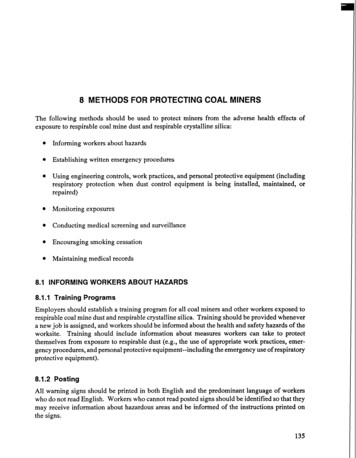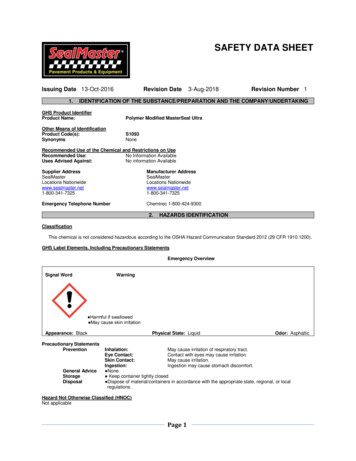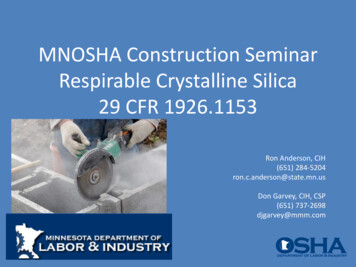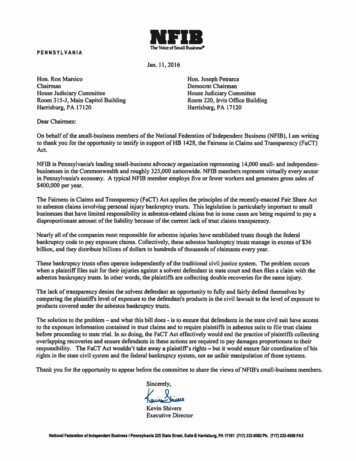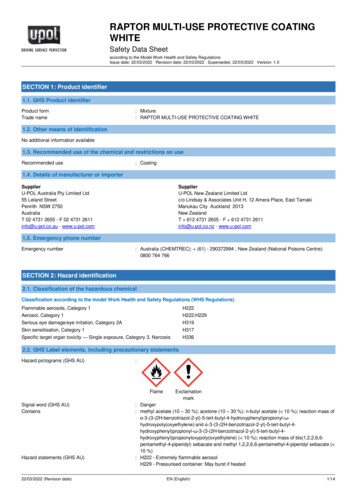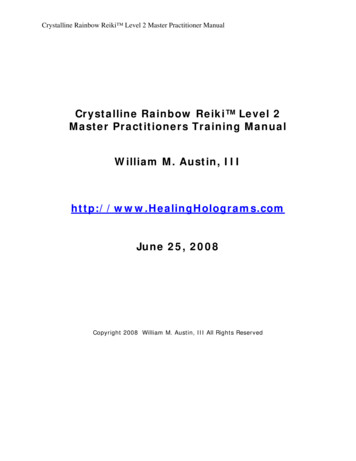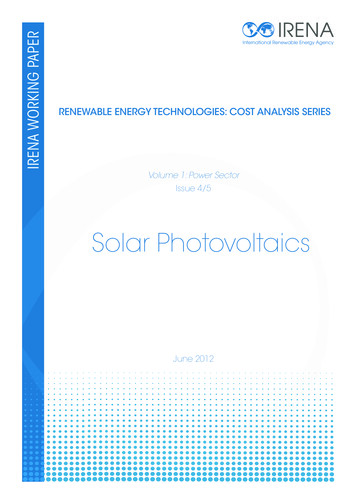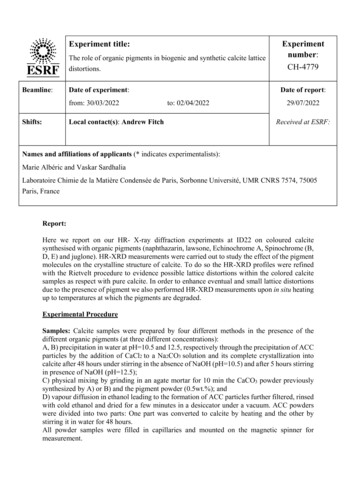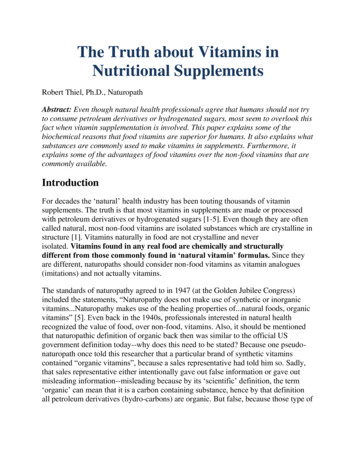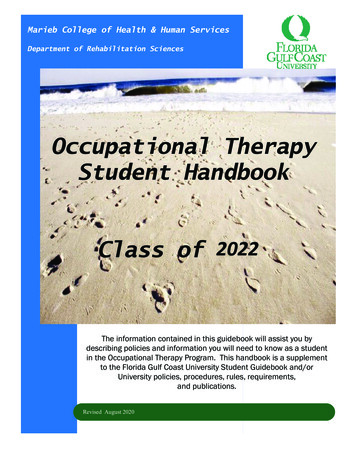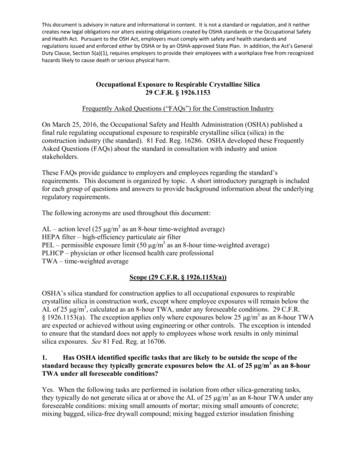
Transcription
This document is advisory in nature and informational in content. It is not a standard or regulation, and it neithercreates new legal obligations nor alters existing obligations created by OSHA standards or the Occupational Safetyand Health Act. Pursuant to the OSH Act, employers must comply with safety and health standards andregulations issued and enforced either by OSHA or by an OSHA-approved State Plan. In addition, the Act’s GeneralDuty Clause, Section 5(a)(1), requires employers to provide their employees with a workplace free from recognizedhazards likely to cause death or serious physical harm.Occupational Exposure to Respirable Crystalline Silica29 C.F.R. § 1926.1153Frequently Asked Questions (“FAQs”) for the Construction IndustryOn March 25, 2016, the Occupational Safety and Health Administration (OSHA) published afinal rule regulating occupational exposure to respirable crystalline silica (silica) in theconstruction industry (the standard). 81 Fed. Reg. 16286. OSHA developed these FrequentlyAsked Questions (FAQs) about the standard in consultation with industry and unionstakeholders.These FAQs provide guidance to employers and employees regarding the standard’srequirements. This document is organized by topic. A short introductory paragraph is includedfor each group of questions and answers to provide background information about the underlyingregulatory requirements.The following acronyms are used throughout this document:AL – action level (25 µg/m3 as an 8-hour time-weighted average)HEPA filter – high-efficiency particulate air filterPEL – permissible exposure limit (50 µg/m3 as an 8-hour time-weighted average)PLHCP – physician or other licensed health care professionalTWA – time-weighted averageScope (29 C.F.R. § 1926.1153(a))OSHA’s silica standard for construction applies to all occupational exposures to respirablecrystalline silica in construction work, except where employee exposures will remain below theAL of 25 µg/m3, calculated as an 8-hour TWA, under any foreseeable conditions. 29 C.F.R.§ 1926.1153(a). The exception applies only where exposures below 25 μg/m3 as an 8-hour TWAare expected or achieved without using engineering or other controls. The exception is intendedto ensure that the standard does not apply to employees whose work results in only minimalsilica exposures. See 81 Fed. Reg. at 16706.1.Has OSHA identified specific tasks that are likely to be outside the scope of thestandard because they typically generate exposures below the AL of 25 µg/m3 as an 8-hourTWA under all foreseeable conditions?Yes. When the following tasks are performed in isolation from other silica-generating tasks,they typically do not generate silica at or above the AL of 25 µg/m3 as an 8-hour TWA under anyforeseeable conditions: mixing small amounts of mortar; mixing small amounts of concrete;mixing bagged, silica-free drywall compound; mixing bagged exterior insulation finishing
system (EIFS) base and finish coat; removing concrete formwork; using block or tile splitters;and using manual (i.e., non-powered) chisels, shears, and utility knives. In addition, tasks whereemployees are working with silica-containing products that are, and are intended to be, handledwhile wet, are likely to generate exposures below the AL under any foreseeable conditions(examples include finishing and hand wiping block walls to remove excess wet mortar, pouringconcrete, and grouting floor and wall tiles).2.Does the standard cover employees who perform silica-generating tasks for only 15minutes or less a day?The standard does not include a specific exemption for tasks with only short-term exposures(e.g., tasks with exposures for 15 minutes a day or less). However, in many cases, employeeswho perform construction tasks for very short periods of time, in isolation from activities thatgenerate significant exposures to silica (e.g., some tasks listed on Table 1, abrasive blasting), willbe exposed below the AL of 25 μg/m3 as an 8-hour TWA under any foreseeable conditions.Short-term silica exposures must be very high in order for those exposures to reach or exceed 25μg/m3 as an 8-hour TWA; for example, if an employee is exposed for only 15 minutes, his or herexposure would have to be higher than 800 µg/m3 for that 15-minute period before the 8-hourTWA exposure would be at or above 25 μg/m3. See 81 Fed. Reg. at 16706. Some examples oftasks that could generate very high short-term exposures include abrasive blasting and grinding,which are typically associated with high levels of visible dust.OSHA has identified carpenters, plumbers, and electricians as types of workers who mayperform tasks (e.g., drilling with a handheld drill) involving occasional, brief exposures to silicathat are incidental to their primary work. See 81 Fed. Reg. at 16706. Provided that theseemployees perform these tasks in isolation from activities that generate significant exposures tosilica, and perform them for no more than 15 minutes throughout the work day, their exposureswill usually fall below the AL of 25 µg/m3 as an 8-hour TWA under all foreseeable conditions;when that is the case, these employees will not be covered by the standard.3.If employees are not covered by the standard because their exposures will remainbelow the AL under any foreseeable conditions, does the employer need to document thisdetermination?No. The standard does not require employers to document determinations about the applicabilityof the standard or the data on which such determinations are based. See 81 Fed. Reg. at 16706.However, an employer may document these determinations for its own purposes. Furthermore,OSHA notes that nothing in the silica standard alters employers’ duty to maintain employeeexposure records under 29 C.F.R. § 1910.1020.4.Do construction employers have to consider exposures from other contractors whendetermining if their employees’ exposures will remain below the AL of 25 µg/m3 as an 8hour TWA under any foreseeable conditions?Yes, if it is foreseeable that the exposures of employees will be affected by exposures generatedby other contractors. On many construction sites, there are multiple contractors performing2
silica-generating tasks. The silica generated by these tasks can migrate to employees of othercontractors. Employers need to consider these secondary exposures when determining whethertheir employees’ exposures will remain below the AL under any foreseeable conditions. If,however, an employer can ensure – either due to the nature and timing of the work, or throughwork practice controls – that its employees will not be exposed to silica generated by othercontractors, then the employer would not need to consider secondary exposures in determiningwhether its employees will be exposed below the AL under any foreseeable conditions.5.If employee exposures will remain below the AL of 25 µg/m3 as an 8-hour TWAunder any foreseeable conditions, does the standard require the employer to complete awritten exposure control plan for the worksite?No. None of the standard’s requirements apply if, without implementing any controls, allemployees’ exposures to silica will remain below the AL of 25 µg/m3 as an 8-hour TWA underany foreseeable conditions.Definitions (29 C.F.R. § 1926.1153(b))The standard defines certain key terms used in the rule. The standard defines such terms as“action level” (a concentration of airborne respirable crystalline silica of 25 µg/m3, calculated asan 8-hour TWA), “employee exposure” (exposure to airborne respirable crystalline silica thatwould occur if the employee were not using a respirator), and “competent person” (an individualwho is capable of identifying existing and foreseeable respirable crystalline silica hazards in theworkplace, and has authorization to take prompt corrective measures to eliminate or minimizethem and the knowledge and ability necessary to fulfill the responsibilities set forth in paragraph(g) of the standard). 29 C.F.R. § 1926.1153(b).6.How can an employer determine who qualifies as a “competent person” under thestandard? Does an employee have to take a particular training class to meet the definitionof a competent person under the standard?The standard does not specify particular training requirements for competent persons. Instead, itdefines a competent person in terms of capability, i.e., whether a designated competent personhas the knowledge and ability to perform the duties prescribed by the standard. The employermust also give the competent person the authority to perform those duties. See 29 C.F.R. §1926.1153(b).To determine whether a given employee has the appropriate knowledge and ability to performthe duties of the competent person, an employer needs to confirm that the employee is capableof:(1) Identifying existing and foreseeable silica hazards; and(2) Promptly eliminating or minimizing those hazards.See 29 C.F.R. § 1926.1153(b). In addition, the employee must be capable of making frequentand regular inspections of job sites, materials, and equipment for purposes of implementing the3
written exposure control plan, to ensure that the engineering controls, work practice controls,required respiratory protection, housekeeping measures, and procedures to restrict access in theworkplace are implemented for the silica-generating tasks listed in the plan. See 29 C.F.R. §1926.1153(g)(1)(i)-(iv), (g)(4).A person with these capabilities (whether acquired through training, education, work experience,or otherwise), who is authorized by the employer to perform the duties of a competent person,qualifies as a competent person under the standard.7.Some provisions in the standard refer to high-efficiency particulate air (HEPA)filters. The standard defines a HEPA filter as a “filter that is at least 99.97 percent efficientin removing mono-dispersed particles of 0.3 micrometers in diameter.” May an employerrely on a manufacturer’s representation of the effectiveness of a filter to comply with thisrequirement?Yes. The standard does not require employers to independently test the effectiveness of filters todetermine if they meet the definition in paragraph (b). Employers can rely on a manufacturer’srepresentation that a filter is at least 99.97 percent efficient in removing mono-dispersed particlesof 0.3 micrometers in diameter or that it is compliant with the OSHA definition of a “HEPAfilter.” However, employers must properly select, use, maintain, and replace HEPA filters inorder to ensure that they continue to function according to the manufacturer’s specifications.Exposure Control Methods (29 C.F.R. § 1926.1153(c) and (d))The standard permits construction employers to select from two methods of compliance tocontrol exposures to respirable crystalline silica: “specified exposure control methods” or“alternative exposure control methods.”Under “specified exposure control methods,” employers can comply by fully and properlyimplementing the engineering controls, work practices, and respiratory protection set forth forthe relevant task on “Table 1.” 29 C.F.R. § 1926.1153(c). Employers that follow Table 1 do nothave to assess employee exposures or separately ensure compliance with the PEL. Table 1includes common construction tasks.For tasks that are not listed on Table 1, or where the employer does not fully and properlyimplement the engineering controls, work practices, and respiratory protection described onTable 1, the employer must comply with “alternative exposure control methods.” 29 C.F.R.§ 1926.1153(d). Under this compliance option, the employer must ensure that no employee isexposed to an airborne concentration of respirable crystalline silica in excess of the PEL of 50µg/m3, calculated as an 8-hour TWA. 29 C.F.R. § 1926.1153(d)(1). The employer must assessexposures using either a performance option or a scheduled monitoring option. 29 C.F.R.§ 1926.1153(d)(2).Further, as with other health standards, employers following alternative exposure controlmethods must use engineering and work practice controls to reduce and maintain employeeexposure to silica to or below the PEL, unless the employer can demonstrate that such controls4
are not feasible. If feasible engineering and work practice controls are not sufficient to reduceemployee exposure to or below the PEL, the employer must nonetheless use those controls toreduce exposures to the lowest feasible level, and then supplement the controls with the use ofrespiratory protection. 29 C.F.R § 1926.1153(d)(3)(i).Specified Exposure Control Methods – Table 18.If all of the jobs and tasks an employer performs are included on Table 1, can theemployer comply with Table 1 exclusively, instead of following alternative exposure controlmethods?Yes. Most of the tasks that generate exposure to silica in construction are listed on Table 1, andOSHA anticipates that most employers will choose to follow Table 1 for tasks listed on the table.9.Many of the entries on Table 1 require employers to “[o]perate and maintain” tools“in accordance with manufacturer’s instructions to minimize dust emissions.” See 29C.F.R. § 1926.1153(c)(1)(i)-(vii), (x)-(xiii), (xvi). If an employer is following Table 1, andemployees are performing one of these tasks, does the silica standard require the employerto follow every element of the tool manufacturer’s instructions?No, the silica standard requires employers to follow manufacturer instructions that are related todust control. In determining which instructions might relate to dust control, employers shouldconsider whether the failure to follow the particular instruction would increase employeeexposure to silica. Examples of manufacturer instructions for minimizing dust emissions couldinclude: Instructions on the use of water, water supply, flow rates, etc., including installation andmaintenance of integrated water delivery systems;Instructions on when to change water, where water supply is reused;Instructions on the use, installation, and maintenance of dust collectors or vacuums,including recommended flow rate (cubic feet per minute (CFM)), HEPA filters, andcapacity;Instructions on the maintenance and replacement of blades; andInstructions on the rotation (e.g., speed, direction) of blades.Examples of manufacturer instructions that are not generally related to minimizing dustemissions include: Warnings related to electrical hazards, guarding hazards, and noise hazards;Instructions regarding the use of personal protective equipment (including respiratoryprotection);Instructions on fueling and refueling; andInstructions on transporting the tool from worksite to worksite.OSHA recognizes that sometimes manufacturers adopt particular instructions to serve multiplepurposes. Where a given instruction is reasonably related to the level of dust generated, the5
standard requires employers to follow that instruction, regardless of whether that instructionserves more than one purpose.OSHA notes that manufacturers’ instructions that do not relate to minimizing dust emissionsmay still be relevant to compliance with other OSHA standards and the OSH Act.10.The manufacturers’ instructions for a number of tools state that respiratoryprotection is required whenever employees use the tools. Does that language supersede therespiratory protection requirements on Table 1?No. The standard does not require employers to follow tool manufacturers’ instructions forrespirator use. Respirator requirements for employers following Table 1 are specified on thetable, and those employers must fully and properly implement the dust control and respiratoryprotection requirements specified for the relevant task. See 29 C.F.R. § 1926.1153(e).11.Some entries on Table 1 require the use of a dust collection system that provides, ata minimum, the air flow recommended by the manufacturer. Does the standard requireemployers to conduct their own air flow assessments to ensure compliance with thisrequirement?No. Employers may normally rely on statements made by the manufacturer of equipment todetermine compliance. Employers do not need to perform their own testing to determine if adust collection system functions at the level required by the standard. However, employers mustproperly select, use, maintain, and replace dust collection systems in order to ensure that theyfunction as designed, e.g., by ensuring that the port and hose are not obstructed.12.For Table 1 tasks performed indoors or in enclosed areas, paragraph (c)(2)(i)requires a means of exhaust as needed to minimize the accumulation of visible airbornedust. Can an employer use a portable fan to comply with this requirement?Yes. When tasks are performed indoors or in enclosed areas, the dispersal of dust can beimpeded, causing dust concentrations to build. In these environments, sufficient air circulation iscritical to ensure the effectiveness of the controls included on Table 1 and to prevent theaccumulation of airborne dust. Thus, the standard requires a means of exhaust in thosecircumstances. The required “means of exhaust” could include: portable fans (e.g., box fans,floor fans, axial fans, oscillating fans), portable ventilation systems, or other systems thatincrease air movement and assist in the removal and dispersion of airborne dust. To be effective,the exhaust ventilation must be positioned to move dust away from workers’ breathing zones andset up so that movements of employees during work, or the opening of doors and windows, willnot negatively affect the airflow. See 81 Fed. Reg. at 16721.13.What constitutes an enclosed area for purposes of compliance with Table 1?Some of the entries on Table 1, as well as paragraph (c)(2)(i), include specific requirements fortasks performed “indoors or in enclosed areas.” This term refers to any areas where, without theassistance of forced ventilation, the dispersal of airborne dust can be impeded and concentrations6
can build up. For example, a work area with only a roof that does not affect the dispersal of dustwould not be considered enclosed; however, an open-top structure with three walls and limitedair movement could be considered enclosed. Parking garages, pits, trenches, and emptyswimming pools may qualify as enclosed areas.14.For a few tasks on Table 1, respirator requirements vary based on task duration,i.e., whether the task is performed for “less than or equal to four hours/shift” or “greaterthan four hours/shift.” Does the employer have to track the exact amount of time thatemployees are performing a job throughout a shift to be in compliance with Table 1?No. Before the task is performed, the employer must make a good-faith judgment about whetherthe task will take more than four hours. This judgment should be based on previous experienceand other available information. If the employer anticipates that an employee will be engaged ina task for more than four hours, the employer must provide the employee, at the beginning of theshift, the respiratory protection required in the “greater than four hours/shift” column on Table 1.If, in contrast, the employer anticipates that an employee will be engaged in a task for four hoursor less, the employer needs to provide respiratory protection in accordance with the “less than orequal to four hours/shift” column (which in many cases does not call for the use of anyrespiratory protection). However, if the employer experiences unforeseen difficulties or othercircumstances that are expected to extend the task duration beyond four hours, the employermust provide the respiratory protection required in the “greater than four hours/shift” column assoon as it becomes evident that the duration of the task may exceed the 4-hour threshold. (In thatsituation, the 4-hour mark is still measured from the beginning of the task, not from the time theexpected duration of the task changes.)For example, in the case of an employee grinding concrete walls indoors, the employer shouldknow, in advance, the area of the surface that is to be worked on in the course of a shift. If,based on the employer’s experience, the time needed to grind that area is typically less than fourhours, the employer would not have to provide the respiratory protection required in the “greaterthan four hours/shift” column. If, however, using the same example, unforeseen circumstancesarise part-way through the task that will result in the task taking more than four hours, theemployer must provide the respiratory protection called for in the “greater than four hours/shift”column as soon as the unforeseen circumstances occur.15.Is an employer following Table 1 required to “minimize dust emissions”? Whatdoes it mean to “minimize dust emissions” in this context?Although many of the entries on Table 1 require employers to “[o]perate and maintain” tools “inaccordance with manufacturer’s instructions to minimize dust emissions,” 29 C.F.R.§ 1926.1153(c)(1)(i)-(vii), (x)-(xiii), (xvi), or to “[o]perate and maintain machine[s] to minimizedust emissions,” 29 C.F.R. § 1926.1153(c)(1)(xiv)-(xv), the standard does not separately requireemployers to minimize dust emissions. An employer generating a limited amount of dust whenengaging in a task listed on Table 1 would not be in violation of the standard if it is fully andproperly implementing the engineering controls, work practices, and respiratory protectionspecified on the Table (including operating and maintaining controls so as to minimizeemissions). A small amount of dust can be expected even with new equipment that is operating7
as intended by the manufacturer. However, a noticeable increase in dust emissions may indicatethat the dust control system is not operating properly.16.If an employer is utilizing water to control dust generated by a crushing machine,and has consistent air monitoring results or objective data demonstrating that exposuresare under the AL of 25 µg/m3 as an 8-hour TWA (and thus below the PEL), is the employerrequired to put operators in ventilated booths or remote control stations, as specified in therelevant entry on Table 1?No. Employers performing tasks listed on Table 1 can choose to follow alternative exposurecontrol methods in paragraph (d) instead of implementing the controls specified on Table 1. Thealternative exposure control methods approach involves assessing employees’ silica exposuresand limiting exposures to the PEL of 50 µg/m3 as an 8-hour TWA by following the hierarchy ofcontrols. See 29 C.F.R. § 1926.1153(d).17.Are handheld powered demolition hammers with bushing tools covered by Table 1?Yes. OSHA considers handheld powered demolition hammers with bushing tools to be a type ofhandheld powered chipping tool. Therefore, employers of employees using handheld powereddemolition hammers with bushing tools can follow Table 1 by fully and properly implementingthe engineering controls, work practices, and respiratory protection specified in paragraph(c)(1)(x).18.Are tile saws covered by Table 1?OSHA considers handheld tile saws to be handheld power saws, for purposes of Table 1(paragraph (c)(1)(ii)). OSHA considers stationary tile saws to be stationary masonry saws, alsocovered by Table 1 (paragraph (c)(1)(i)). Employers of employees using these types of tile sawscan follow Table 1 by fully and properly implementing the engineering controls and workpractices in the specified paragraphs.Alternative Exposure Control Methods19.Does an employer using alternative exposure control methods for compliance haveto conduct sampling of all employees performing all job tasks?No. The standard requires employers to assess the exposure of each employee who is or mayreasonably be expected to be exposed to silica at or above the AL of 25 µg/m3 as an 8-hourTWA, but it allows employers to fulfill this obligation using either the “performance option” orthe “scheduled monitoring option.” 29 C.F.R. § 1926.1153(d)(2)(i). Under the performanceoption, employers must assess each employee’s 8-hour TWA exposure using any combination ofair monitoring data or objective data, provided that the data is sufficient to accuratelycharacterize employee exposures to silica. See 29 C.F.R. § 1926.1153(d)(2)(ii).The term “objective data” means information, such as air monitoring data from industry-widesurveys or calculations based on the composition of a substance, demonstrating employee8
exposure to silica associated with a particular product or material or a specific process, task, oractivity. The data must reflect workplace conditions closely resembling, or with a higherexposure potential than, the processes, types of material, control methods, work practices, andenvironmental conditions in the employer’s current operations. See 29 C.F.R. § 1926.1153(b).Types of data and exposure assessment strategies that may qualify as objective data include: Data from industry-wide surveys;Data provided by equipment manufacturers;Data provided by trade or professional associations;Exposure mapping (determining exposures associated with particular locations based oninformation obtained from sources that may include personal samples, area samples, anddirect-reading instruments);Calculations based on the composition of a substance;Calculations based on the chemical and physical properties of a substance (in thoseinstances where a substance’s physical and chemical properties demonstrate employeeexposure to silica associated with a particular product or material or a specific process,task, or activity); andThe employer’s historical air monitoring data, including data obtained prior to theeffective date of the standard.The preamble to the standard provides more ideas about data and exposure assessment strategiesthat could qualify as or generate objective data. See 81 Fed. Reg. at 16763.When employers rely on objective data generated by others as an alternative to developing theirown data, they are responsible for ensuring that the data relied upon accurately characterize eachemployee’s exposures.Under the scheduled monitoring option, employers must perform initial monitoring to assess the8-hour TWA exposure for each employee on the basis of one or more personal breathing zone airsamples that reflect the exposures of employees on each shift, for each job classification, in eachwork area. Depending upon the results of the sampling, the standard may require additionalsampling at set intervals. Where several employees perform the same job tasks on the same shiftand in the same work area, employers utilizing the scheduled monitoring option may sample arepresentative fraction of the employees in order to meet these requirements. In representativesampling, the employer must sample the employee(s) expected to have the highest exposure tosilica. See 29 C.F.R. § 1926.1153(d)(2)(iii).20.For alternative exposure control methods, the standard requires employers to assessthe exposure of each employee who is or may reasonably be expected to be exposed to silicaat or above the AL using either the performance option or the scheduled monitoringoption. See 29 C.F.R. § 1926.1153(d)(2)(ii) & (iii). If an employer reasonably expects itsemployee’s exposure to remain below the AL, does the standard require the employer toassess that employee’s exposure using one of these two options?No. The standard only requires an employer using alternative exposure control methods toconduct an exposure assessment if it is reasonable for the employer to expect that exposures will9
be at or above the AL. See 29 C.F.R. § 1926.1153(d)(2)(i). An exposure assessment is notrequired if the employer has made a reasonable determination that exposures will remain belowthe AL due to the use of engineering or work practice controls. (Note that this is in contrast tothe determination of whether an employee’s exposure is covered by the standard – adetermination that must be made without regard to the decrease in exposures that occurs due tothe use of engineering and work practice controls. See 29 C.F.R. § 1926.1153(a).)To be reasonable, the employer’s expectation that engineering and work practice controls willkeep employee exposures below the AL must be based on relevant evidence or experience, e.g.,data provided by equipment manufacturers or trade or professional associations, air monitoringresults, or experience using the relevant controls effectively in similar circumstances. Thepersistent presence of visible dust, an equipment malfunction, or another unexpected event thatcould affect employee exposures may indicate that it is no longer reasonable to expect employeeexposures to remain below the AL. In those cases, the employer must take prompt correctivemeasures and, depending on the circumstances, may also need to conduct an exposureassessment to verify corrective measures are effective. See 81 Fed. Reg. at 16761.21.Under the scheduled monitoring option, do employers have to monitor exposuresevery time a new job is started (and thus a new work area is created)?Following initial monitoring, the employer can continue to perform periodic monitoring at thefrequency specified in the standard, provided that the task and the workplace conditions in thenew work area are substantially similar, in that they are not reasonably expected to result inexposures above those detected during the most recent monitoring. See 29 C.F.R. §1926.1153(d)(2)(iii), (d)(2)(iv). This applies whether the new work area is on the same or asubsequent jobsite.22.Can an employer use the scheduled monitoring option, but then switch to theperformance option?Yes. The employer has the option of switching to the performance option, and can use airmonitoring data generated during scheduled monitoring to fulfill assessment requirements underthe performance option, provided that the air monitoring data relied on is sufficient to accuratelycharacterize employee exposures. When following either exposure assessment option under thesilica standard, the employer must reassess exposures following any changes in the productionprocess, co
who is capable of identifying existing and foreseeable respirable crystalline silica hazards in the workplace, and has authorization to take prompt corrective measures to eliminate or minimize them and the knowledge and ability necessary to fulfill the responsibilities set forth in paragraph (g) of the standard). 29 C.F.R. § 1926.1153(b).
